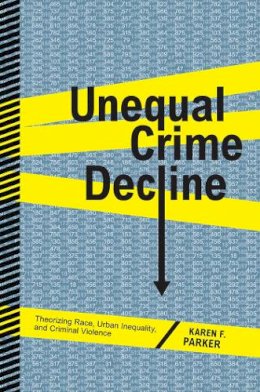
Unequal Crime Decline: Theorizing Race, Urban Inequality, and Criminal Violence
Karen F. Parker
2009 Choice Outstanding Academic Title
Crime in most urban areas has been falling since 1991. While the decline has been well-documented, few scholars have analyzed which groups have most benefited from the crime decline and which are still on the frontlines of violence—and why that might be. In Unequal Crime Decline, Karen F. Parker presents a structural and theoretical analysis of the various factors that affect the crime decline, looking particularly at the past three decades and the shifts that have taken place, and offers original insight into which trends have declined and why.
Taking into account such indicators as employment, labor market opportunities, skill levels, housing, changes in racial composition, family structure, and drug trafficking, Parker provides statistics that illustrate how these factors do or do not affect urban violence, and carefully considers these factors in relation to various crime trends, such as rates involving blacks, whites, but also trends among black males, white females, as well as others. Throughout the book she discusses popular structural theories of crime and their limitations, in the end concentrating on today’s issues and important contemporary policy to be considered. Unequal Crime Decline is a comprehensive and theoretically sophisticated look at the relationship among race, urban inequality, and violence in the years leading up to and following America’s landmark crime drop.
Product Details
About Karen F. Parker
Reviews for Unequal Crime Decline: Theorizing Race, Urban Inequality, and Criminal Violence
Choice
"All of this can be summarized in the following three reasons that Parkers book is important: she begins with a question that deserves an answer, she demonstrates how that question is far more complex than most have thought, and she offers an answer that is theoretically rich."
Contemporary Sociology
"Her analysis is not only a thorough review of the debate on the link between violent crime and unemployment; it is an exploration into the complex intertwining between ethnicity, gender, population composition and political economy in violent crime . . . a hugely rewarding read."
British Journal of Criminology
"Parkers theoretical integration is so straightforward and intuitive that it makes one wonder why it took so long for sociologists to consider such an amalgamation. Sociologists interested in the urban economy should seriously consider the ways in which labor market changes stratify racial groups along dimensions of crime and violence. Meanwhile, criminologists would do well to heed Parkers call for a richer and more dynamic theoretical treatment of the economy in their models of changing crime rates."
American Journal of Sociology
"Parker's book is an important addition to our understanding of the crime drop of the 1990s. In fact, her research sheds new light on this important social trend, dispels myths that continue to surround it, and demonstrates how criminology theory has not been particularly relevant to our understanding of how and why it occured."
Bruce D. Stout
Journal of American Ethnic History
"The absence of obfuscation is exemplary and this unpretentious text is student-friendly as well as useful for all postgraduate students, academics and policy-makers who wish to furnish themselves with a clear, empirically grounded and sophisticated picture of the 'crime drop'"
Steve Hall
Urban Studies Journal
"The crime decline that began in the early 1990s and ran for more than a decade is the largest sustained drop in crime rates ever recorded in the United Statesand yet this remarkable event has gone largely unheralded. Parker illuminates this unexplored terrain by shining a light on the unevenness of the decline across key subgroups defined especially by race, gender and class. Her book is required reading for anyone interested in the make up of this fascinating piece of criminology history."
Gary LaFree,author of Losing Legitimacy: Street Crime and the Decline of Social Institutions in America "There has been much speculation as to the source and meaning of the crime drop of the 1990s. Yet, relatively unexamined is whether crime rates declined uniformly across all groups and, if not why not? In this important book, Parker carefully examines homicide trends for different combinations of race and gender specific groups over three decades and convinces us that crime trends are far from uniform. What then accounts for the race and gender disparities in homicide trends? Parker offers more nuanced explanations by exploring how changes in the urban landscape over several decades have differentially affected blacks and whites and males and females. Parkers book is a significant achievement, merging sophisticated quantitative techniques and analysis with sociological insights about structural changes in our cities that also affect urban crime rates. She has raised important questions about the crime drop and at the same time has provided a number of new directions for future research. This is a provocative and stimulating book which should prompt criminologists to more carefully deconstruct crime patterns and trends by race and gender."
Sally S. Simpson,author of Corporate Crime, Law, and Social Control
